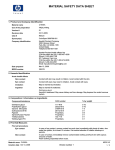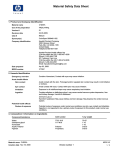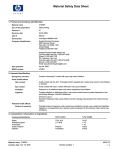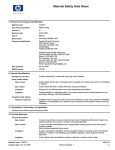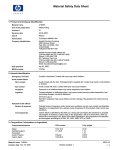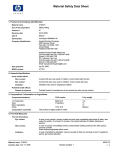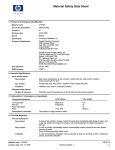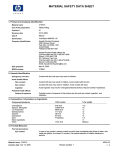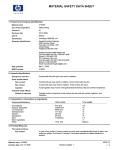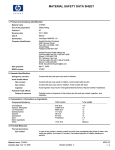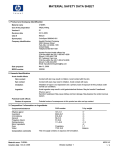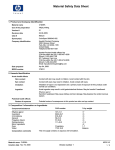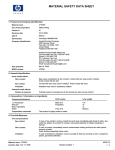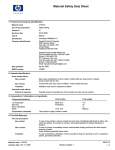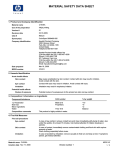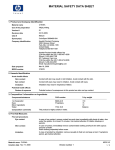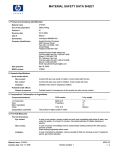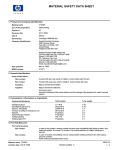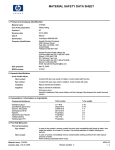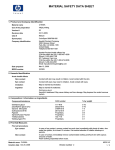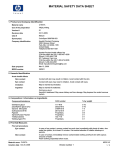Download HP PM301 Cyan
Transcript
MATERIAL SAFETY DATA SHEET 1. Product and Company Identification Material name Use of the preparation Version # Revision date CAS # Synonym(s) Company identification CH202A Inkjet printing. 01 03-14-2009 Mixture ColorSpan 0900461-001 Hewlett-Packard Company 3000 Hanover Street Palo Alto, CA 94304-1185 United States Telephone 650-857-1501 Hewlett-Packard health effects line (Toll-free within the US) 1-800-457-4209 (Direct) 1-503-494-7199 HP Customer Care Line (Toll-free within the US) 1-800-474-6836 (Direct) 1-208-323-2551 Email: [email protected] Date prepared MSDS number Mar 13, 2009 362670 2. Hazards Identification Emergency overview Acute health effects Skin contact Eye contact Inhalation Ingestion Contains Humectant; Contact with eyes may cause irritation. Avoid contact with the skin. Prolonged and/or repeated skin contact may result in mild irritation or redness. Avoid contact with eyes. Contact with eyes may cause irritation. Exposure to oil mist/fume/vapor may cause respiratory tract irritation. Contains ethylene or diethylene glycol, may cause central nervous system depression, liver and kidney damage. Harmful if swallowed. Diethylene glycol Harmful if swallowed. May cause kidney and liver damage. May depress the central nervous system. Potential health effects Routes of exposure Potential routes of exposure under normal use conditions are skin, eye contact and inhalation. Ingestion is not expected to be a primary route of exposure for this product under normal use conditions. 3. Composition / Information on Ingredients Component/substance CAS number % by weight Water Diethylene glycol Humectant Acrylic Polymer Pigment 7732-18-5 111-46-6 70-97 1-10 1-10 0.05-5 0.05-5 Material name CH202A Creation date Oct 21, 2008 Polymer Proprietary Version number 1 MSDS US 1/ 5 MATERIAL SAFETY DATA SHEET 4. First Aid Measures First aid procedures Eye contact Skin contact Inhalation Ingestion In case of eye contact, remove contact lens and rinse immediately with plenty of water, also under the eyelids, for at least 15 minutes. Get medical attention. In case of contact, immediately remove contaminated clothing and flush skin with copious amounts of water. Wash clothing separately before reuse. In case of accident by inhalation: remove casualty to fresh air and keep at rest. Get medical attention, if needed. If not breathing, give artificial respiration or give oxygen by trained personnel. In the unlikely event of swallowing contact a physician or poison control center. 5. Fire Fighting Measures Flash point and method Hazardous combustion products > 200 °F (> 93.3 °C) Closed Cup; Carbon monoxide and carbon dioxide. Extinguishing media Suitable extinguishing media Use any media suitable for the surrounding fires. Protection of firefighters Protective equipment and precautions for firefighters Wear suitable protective equipment. 6. Accidental Release Measures Personal precautions Environmental precautions Methods for cleaning up Avoid contact with skin. Do not touch or walk through spilled material. Use personal protective equipment to minimize exposure to skin and eye. In the case of vapor formation use a respirator with an approved filter. Do not flush into surface water or sanitary sewer system. Absorb spill with inert material (e.g., dry sand or earth), then place in a chemical waste container. Clean up in accordance with all applicable regulations. Clean-up methods - small spillage; Flush area with flooding quantities of water. 7. Handling and Storage Handling Storage Avoid contact with skin, eyes and clothing. Use personal protective equipment as required. Use only with adequate ventilation. When using, do not eat, drink or smoke. Keep out of the reach of children. Keep tightly closed in a dry, cool and well-ventilated place. Store at room temperature. 8. Exposure Controls / Personal Protection Personal protective equipment General Eye / face protection Skin protection Respiratory protection General hygeine considerations Material name CH202A Creation date Oct 21, 2008 Eye wash fountain and emergency showers are recommended. Wear safety glasses; chemical goggles (if splashing is possible). Wear appropriate chemical resistant clothing. Wear appropriate chemical resistant gloves. Inhalation of vapor and ingestion are not expected to be significant routes of exposure for this product under normal use conditions. Provide adequate ventilation. Handle in accordance with good industrial hygiene and safety practice. Avoid contact with skin, eyes and clothing. When using, do not eat, drink or smoke. Wash hands before breaks and immediately after handling the product. Launder contaminated clothing before reuse. Version number 1 MSDS US 2/ 5 MATERIAL SAFETY DATA SHEET 9. Physical & Chemical Properties Color Odor threshold Physical state Form pH Melting point Freezing point Boiling point Flash point Evaporation rate Flammability Flammability limits in air, upper, % by volume Flammability limits in air, lower, % by volume Vapor pressure Vapor density Specific gravity Relative density Solubility (water) Partition coefficient (n-octanol/water) Auto-ignition temperature Decomposition temperature VOC Cyan Not available. Liquid. Aqueous solution. 8 < 32 °F (< 0 °C) Not available. > 212 °F (> 100 °C) > 200 °F (> 93.3 °C) Closed Cup; Not available. Not available. Not available. Not available. Not available. Not available. 1 Not available. Miscible Not available. Not available. Not available. < 200 g/L 10. Chemical Stability & Reactivity Information Chemical stability Incompatible materials Possibility of hazardous reactions Stable under normal storage conditions. None established. Hazardous polymerisation does not occur 11. Toxicological Information Acute toxicity Mutagenicity No information available. Not mutagenic in AMES Test. 12. Ecological Information Ecotoxicity Persistence and degradability No data is available on the product itself. Not available. 13. Disposal Considerations Disposal instructions Dispose of in compliance with federal, state, and local regulations. Do not allow this material to drain into sewers/water supplies. 14. Transport Information IATA Not regulated as dangerous goods. Material name CH202A Creation date Oct 21, 2008 Version number 1 MSDS US 3/ 5 MATERIAL SAFETY DATA SHEET 15. Regulatory Information US federal regulations US EPA TSCA Inventory: All chemical substances in this product comply with all rules or orders under TSCA. CERCLA (Superfund) reportable quantity None Superfund Amendments and Reauthorization Act of 1986 (SARA) Immediate Hazard - No Hazard categories Delayed Hazard - No Fire Hazard - No Pressure Hazard - No Reactivity Hazard - No Section 302 extremely hazardous substance Section 311 hazardous chemical No No State regulations US - Pennsylvania RTK - Hazardous Substances: Listed substance Diethylene glycol (111-46-6) Listed. 16. Other Information HMIS® ratings NFPA ratings Issue date Revision Disclaimer Material name CH202A Creation date Oct 21, 2008 Health: 1 Flammability: 1 Physical hazard: 0 Personal protection: B Health: 1 Flammability: 1 Instability: 0 Mar 13 2009 8:37PM 1 This Safety Data Sheet document is provided without charge to customers of Hewlett-Packard Company. Data is the most current known to Hewlett-Packard Company at the time of preparation of this document and is believed to be accurate. It should not be construed as guaranteeing specific properties of the products as described or suitability for a particular application. This document was prepared to the requirements of the jurisdiction specified in Section 1 above and may not meet regulatory requirements in other countries. Version number 1 MSDS US 4/ 5 MATERIAL SAFETY DATA SHEET Explanation of abbreviations ACGIH CAS CERCLA CFR COC DOT EPCRA IARC NIOSH NTP OSHA PEL RCRA REC REL SARA STEL TCLP TLV TSCA VOC Manufacturer information Material name CH202A Creation date Oct 21, 2008 American Conference of Governmental Industrial Hygienists Chemical Abstracts Service Comprehensive Environmental Response Compensation and Liability Act Code of Federal Regulations Cleveland Open Cup Department of Transportation Emergency Planning and Community Right-to-Know Act (aka SARA) International Agency for Research on Cancer National Institute for Occupational Safety and Health National Toxicology Program Occupational Safety and Health Administration Permissible Exposure Limit Resource Conservation and Recovery Act Recommended Recommended Exposure Limit Superfund Amendments and Reauthorization Act of 1986 Short-Term Exposure Limit Toxicity Characteristics Leaching Procedure Threshold Limit Value Toxic Substances Control Act Volatile Organic Compounds Hewlett-Packard 11311 K-Tel Drive Minnetonka, MN 55343 US Product Information 1-800-925-0563 Version number 1 MSDS US 5/ 5





